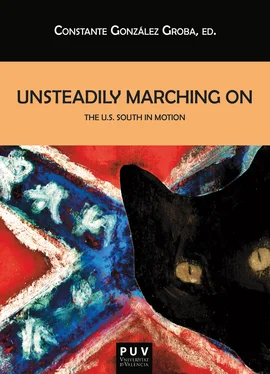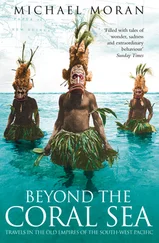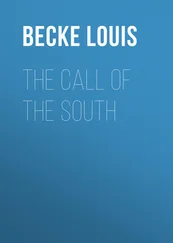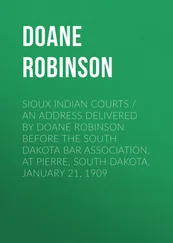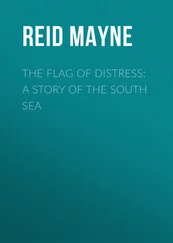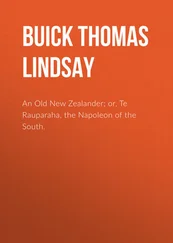The final section of the volume covers a variety of literary journeys into and out of the South. In the first essay here, Nahem Yousaf looks into the untold story of a southern community fighting the ravages of AIDS, as told by immigrant doctor Abraham Verghese in his memoir My Own Country: A Doctor’s Story of a Town and Its People in the Age of AIDS . The memoir examines the links that Verghese establishes between his experience as an Indian immigrant arriving in Johnson City, East Tennessee via Ethiopia, India and urban North America, and the experiences of a community within a community living with HIV. It describes how Verghese, between 1985 and 1989, found a homeplace in “another country,” the beautiful area at the foot of the Smoky Mountains from which his AIDS patients had once escaped, but to which they now return to die. Yousaf reads Verghese’s memoir in terms of a series of cultural flows and concurs with Werner Sollors’s thesis that the traditional US settler-frontier is revised by new immigrants in new places. This paper also considers the cultural impact of Verghese’s narrative through the different manifestations in which it reaches different audiences−the first mode in which Verghese explored HIV in his southern narrative was the short story “Lilacs” ( The New Yorker , 1991), which led to the creation of the memoir, published in 1994. This was in turn adapted by the Indian director Mira Nair to the 1998 movie My Own Country . Yousaf maintains that “In My Own County [Verghese] tracks the voyage of discovery he makes to the realization that his patients comprise much of his own story too.”
Suzanne Jones analyzes Connie May Fowler’s first novel Sugar Cage (1992), which opens in 1945 and spans more than two decades, and which examines the race relations of two generations of southerners. Jones reads the novel as a narrative which provides the lenses for readers to see beyond the regional to the global South. She pays attention to the ways in which magical realism functions as an interesting connective tissue between black and white worlds in Florida, in a work whose author explores cultural and transnational complexities, especially the importation of African and Haitian belief systems and Florida’s reliance on Haitian migrant workers. Jones embraces the theories of Antonio Benítez-Rojo, who argues that Caribbean revolutionary discourses, which reacted to slavery, colonialism, and the plantation economy, inform the literary expression that is known as magical realism. By the conclusion of Sugar Cage , several of Fowler’s characters have crossed color lines and national boundaries to make personal connections, though practically no institutional changes. In her narrative of southern race relations, Fowler depicts a migrant worker of mixed Haitian and Seminole Indian ancestry, Soleil Marie Beauvoir, thus complicating the biracial history of the South; she also includes an interracial romance as a metaphor for the potential transformations that the local can have on the region and the nation. At the same time she shows how agribusiness has spawned a neo-plantation system that exploits migrants of color to the present day. As Jones writes, “Both the civil rights movement and the Vietnam War complicate the domestic dramas of Fowler’s working-class characters and remind readers that the young lovers’ [Soleil Marie and the white teenager Emory Looney] romance is part of a larger political and international story, in which resolution does not come easily.” Jones concludes that the fact that Fowler chooses a partner of color for her white protagonist is proof of the reach of Caribbean cultures into the US South, and “[t]hat her mixed-race character Soleil Marie turns to transcultural improvisation to fulfill her dream makes the knowledge of several characters more powerful than that of one.”
Marcel Arbeit’s essay looks at the connection between forced movement and individual identity, and analyzes the ordeal of a southerner confronting the taboo of breaking away from the family to go West in The Good Brother , the first novel by the Appalachian writer Chris Offutt. The protagonist journeys westward in highly dramatic circumstances and with unsatisfactory results, as Montana holds very few desirable things in store for him. The novel describes the life journey of a loser named Virgil Caudill from the Appalachian part of Kentucky, where the hills seem to move more than the inhabitants of the hollows, one of those environments that Zygmunt Bauman describes as “communities of life and fate” (11). For the first time in his life, the protagonist has to face the interrelated problems of mobility, migration and identity, and he confronts the paradox of identity – how to reconcile moving with the desire for security. To gain security and acceptance in the Appalachian community, Virgil has to avenge his brother and then escape to a world outside his native region; taking the new name Joe Tiller, he goes on to inhabit what Arbeit calls “the void between two lives.” Virgil is capable of shucking off his Kentuckian identity to become a westerner, and at the same time he finds features of Montana similar to the hills of Kentucky, which itself suggests a vicious circle in which heading westward is not much different than heading back home. None of the identities that Virgil/Joe tries fits him well, and he is permanently unsure about where he stands. There is uncertainty at the novel’s close as to which direction the protagonist will take and, as Arbeit argues, the open ending suggests that he is after all, no matter how unintentionally, confirming his original Appalachian identity.
A notable expert in transatlantic literary relations, Waldemar Zacharasiewicz traces the personal and literary pilgrimages of William Goyen and Gail Godwin through European locations in the 1950s and 60s. He highlights the special relationship between the American South and European culture that goes back to the antebellum period, when some southerners felt more affinity with Old Europe than with the US North. In the 20th century the Agrarians would also express their preference for transatlantic culture. The authors that Zacharasiewicz studies here felt attracted to individual European countries, in this way transcending the limitations of their native region through encounters with other people and other landscapes yet remaining anchored, in differing degrees, to their home turf and seeing the South (inside themselves) in a new light provided by the perspective of distance. As so many others had done before them, Goyen and Godwin escaped from the restrictive codes of behavior and gender roles of their native region while they also became aware of hitherto unknown facets of their southernness. Through the fiction that they write about southerners in Europe they continue to chronicle their native region. During his European sojourn Goyen retained his rootedness in the small-town South, whereas Godwin was more insistent on escaping from an intolerably patriarchal South, and she incorporated a transatlantic viewpoint in her predominantly autobiographical fiction. Zacharasiewicz concludes that whereas these authors both physically and imaginatively transcended southern borders, “their fictional worlds to various degrees remained anchored in the experiences of their childhood and youth as they continued to ‘look homeward,’ definitely in their correspondence and in the narration of return visits of their characters to the South.”
Valeria Gennaro Lerda deals with issues relating to the “Great Migration” of African-Americans from the South (1916-18). Drawing on primary sources such as the David R. Cocker Collection and the Daniel L. Tompkins Collection, she describes the resistance of southern white entrepreneurs and land owners who depended on black labor for their operations in the South. Cocker and Tompkins were eager to exert social control over the black population, and were most active in the resistance to the migration of black laborers, taking action against northern agents and supporting state legislation to prevent the recruitment of these laborers. Gennaro Lerda posits that the Great Migration, which constituted a threat to the very fabric of social and economic relations in the South, also showed a failure of the New South creed of southern progressivism, because about half a million workers migrated from a land which did not answer to the promise of a new economic era.
Читать дальше
